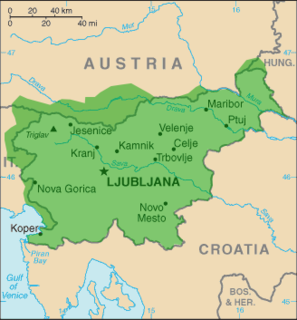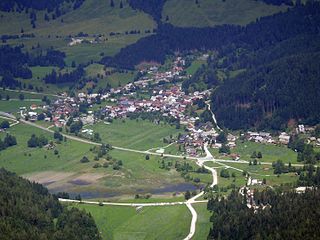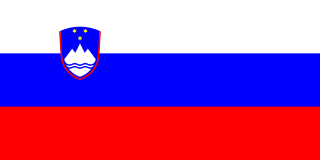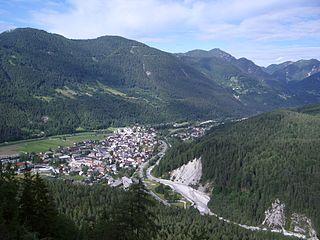
Kranjska Gora is a town in northwestern Slovenia, on the Sava Dolinka River in the Upper Carniola region, close to the Austrian and Italian borders. It is the seat of the Municipality of Kranjska Gora.

Planica is an Alpine valley in northwestern Slovenia, extending south from the border village of Rateče, not far from another well-known ski resort, Kranjska Gora. Further south, the valley extends into the Tamar Valley, a popular hiking destination in Triglav National Park.
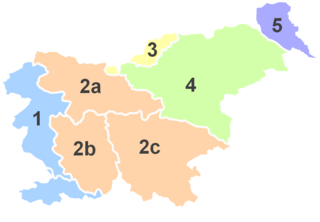
Upper Carniola is a traditional region of Slovenia, the northern mountainous part of the larger Carniola region. The centre of the region is Kranj, while other urban centers include Jesenice, Tržič, Škofja Loka, Kamnik, and Domžale. It has around 300,000 inhabitants or 14% of the population of Slovenia.
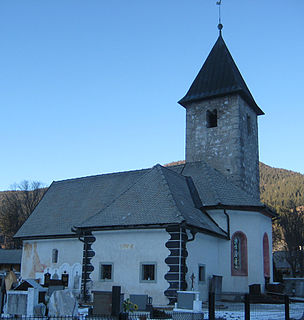
St. Thomas's Church in Rateče, Kranjska Gora, Slovenia, is one of the oldest churches in the upper Sava Valley, confirmed by written documents and excavations as well as the church's original furnishings.
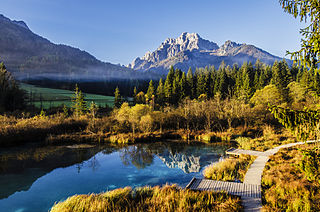
Zelenci Springs is a nature reserve near the town of Kranjska Gora, in the far northwestern corner of Slovenia. It is the source of the Sava Dolinka River, a tributary of the Danube.

Mojstrana is a village in the Municipality of Kranjska Gora in the Upper Carniola region of Slovenia.

The Upper Sava Valley is an alpine valley in the Upper Carniola region of Slovenia. The Sava Dolinka River flows along it. It begins in Rateče at an elevation of 870 m and ends at Moste at 560 m. It is the geographical border between the Julian Alps and the Karawanks. It was created on a tectonic fault that runs down the middle of the valley. Its geomorphological forms are a result of the actions of the river and glaciers. A number of smaller valleys lead into it from both sides.
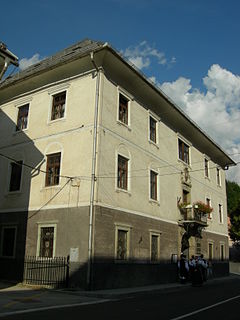
The Kos Manor is a 16th-century manor house located in the Murova neighborhood of the town of Jesenice, Slovenia, at the street address of Cesta maršala Tita 64. It is one of four so-called "ironworks castles" built in the area during the 16th and early 17th centuries by owners of local iron-mining and -processing facilities, in what were then the clustered settlements of Plavž, Sava, Murova and Javornik, amalgamated into the town of Jesenice in 1929. The Bucellini-Ruard Manor in Sava is another survivor of the original four; the Plavž and Javornik manors have been torn down.

Podkoren is a settlement in the Municipality of Kranjska Gora in the northwestern Upper Carniola region of Slovenia.

Srednji Vrh is a settlement in the Municipality of Kranjska Gora in the Upper Carniola region of Slovenia.

Zgornja Radovna is a dispersed settlement in the Municipality of Kranjska Gora, northwestern Slovenia, traditionally belonging to the Upper Carniola region. The village lies at the juncture of the Kot Valley and the northern part of the Krma Valley. The Radovna River, a tributary of the Sava Dolinka, emerges under the Jutrova Skala Slope in the northeastern part of the settlement.
The Jesenice Upper Sava Museum is a regional museum based in the town of Jesenice and the neighboring Municipality of Kranjska Gora, both in northwestern Slovenia. The museum's name refers to the general area it documents, the upper Sava Dolinka Valley. Its holdings include two restored historic farmhouses, the archives of the KID company, and display spaces in the two surviving "ironworks castles", manors built in the area during the 16th and early 17th centuries by the owners of local iron-mining and iron-processing works. The museum was established in its present form in 1992, although several of its constituent facilities operated independently beforehand.
The Liznjek Farm is an ethnographic museum housed in a renovated 18th-century farmhouse, located in the centre of the town of Kranjska Gora, Slovenia, at the street address 63 Borovška cesta. It is administered by the Upper Sava Museum, based in nearby Jesenice. The farm presents the living conditions of a wealthy peasant family of the mid-19th century.

The Russian Chapel on the Vršič Pass is a Russian Orthodox chapel located on the Russian Road on the northern side of the Vršič Pass in northwestern Slovenia. The chapel, dedicated to Saint Vladimir, was built by Russian prisoners of war engaged in forced labor in the area during World War I. It serves as both a war memorial and a symbolic link between Slovenia and Russia.

Weissenfels Castle is a castle ruin above the settlement of Fusine in Valromana in the extreme northeast corner of Italy. The ruins are located 5.7 kilometers (3.5 mi) from the tripoint between Slovenia, Austria, and Italy.

The Nadiža is a mountain stream near the town of Kranjska Gora, in the far northwestern corner of Slovenia. Springing from a bare rockface on the eastern slope of Mount Zadnja Ponca above the Tamar Valley in the Julian Alps, it is the first source of the Sava Dolinka River, the longer of the two sources of the Sava, the longest Slovene river at 221 km (137 mi) and a tributary of the Danube.
The Gail Valley dialect is the westernmost Slovene dialect in the Carinthian dialect group, spoken in parts of southern Carinthia in Austria, in the northeasternmost part of the Province of Udine in Italy, and in northeastern Upper Carniola in Slovenia.

The Municipality of Bovec is a municipality in northwestern Slovenia. Its center is the town of Bovec. As of June 2016, its mayor is Valter Mlekuž.

The Municipality of Kranjska Gora is a municipality on the Sava Dolinka River in the Upper Carniola region of northwest Slovenia, close to the Austrian and Italian borders. The seat of the municipality is the town of Kranjska Gora.
